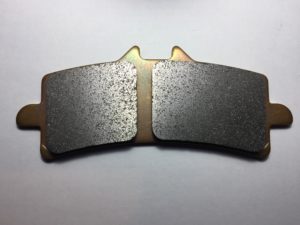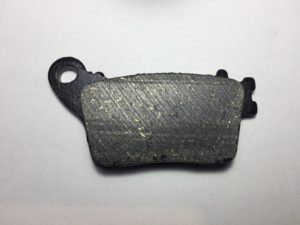35Braking 15Pad
The transcript of the dialogue with my guest, Tommy Coleman, follows, and is also embedded as an audio file. Enjoy, and please leave your comments. To comment, scroll down to the bottom of the page and click the link symbol in the purple circle on the left hand side of the page. Thank you!
Daphne: For this post it’s my privilege to have as a co-host, Mr. Thomas (Tommy) Coleman, a motorcycle mechanic at GP Motorcycles in San Diego, and a former student of mine, who has taken three semesters of chemistry courses as he pursues his dream of becoming a physician. Our topic is brake pad materials and design.
Welcome, Tommy! How long have you been working as a motorcycle mechanic at GP and what are your specialties?
Tommy: I’ve been working at the dealership for 16 years now, and nearly all of that time has been spent doing collision repair. Some of the collisions come in from the racetrack, but mostly it’s like street-related losses from sport riding and parking lot tip-overs. My job, ultimately, is to get the bike back in action and make sure it’s 100% functional and safe.
Daphne: That’s fantastic! You know, you also recently completed three semesters of chemistry and your next step will be Organic Chemistry. What are you looking forward to the most as you continue your studies?
Tommy: Right now I’m doing my best to learn the sciences as if they were like a collective language. I feel like if I gain a basic command of this language, it will help to serve me in taking the MCAT and further, to retain the concepts long-term so I can pretend to my future patients that I am a scientist!
Daphne: Ha!
Tommy: One thing I’m really looking forward to right now is learning organic chemistry. Finally, after all of the calculation-based chemistry courses, the organic chemistry series is more like using my right-brain neural pathways and feeling like a creative person again!
Daphne: Excellent. I know that you’ll do well and I hope you’ll enjoy Organic Chemistry as much as I do. Now, tell me your thoughts on brake pad design, with, let’s say, a comparison of two or three types of brake pads and the differences in their design and the materials from which they’re made.
Tommy: Well, there are two main types of brake pads: there’s organic and then there’s sintered.
I don’t personally have hard data on as far as like, longevity, between the two types – but in my experience, they seem similar in that regard. But I can tell you though, that the organic pads seem softer and the friction material crumbles a lot easier than the sintered pads when you install them like when you have to use a metal object to retract the caliper pistons. That has always given me the impression that the sintered would have to last a lot longer.
Organic brake pads for the rear is probably the best choice because if you’re talking sport riding applications, the capacity for too much rear braking power can be dangerous. An experienced sport rider will sometimes get 100% of their stopping power from front-end braking only. When they do that, the front end will dive and will thus lighten the rear end of the motorcycle. And when that happens while applying the rear brake, even very slightly, the rear tire is prone to locking up and skidding. If this type of skidding is induced while trail braking into a corner, a high side event can be precipitated. That being said, it is almost always better to run organic pads on the rear end of a sport motorcycle.
If you’re riding a Harley, though, I would opt for the sintered rear pad because due to the weight distribution of most cruiser type motorcycles, rear braking can provide a large percentage of the total stopping power, even when under emergency braking situations.
I think in my opinion, the perfect configuration for any sport motorcycle would be a sintered pad in the front with a cast iron rotor, for longevity, and then I would use an organic pad and stock brake rotor for the rear.
Daphne: Cool!
Tommy: Outside of performance stuff, I think one of the coolest things about sintered brake pads is the sound they make while you’re braking. This can be quite audible even with a helmet on covering the ears. Sometimes, with certain kinds of, certain braking systems, the pads will even drag enough to elicit sound at all times while riding the motorcycle. It’s kind of like a real loud hum or hiss. It’s really neat! So, additionally, there is a visual aspect of a sintered pad that kind of sets them apart from an organic pad. If you wanted to see whether or not your bike is running sintered pads – you didn’t know – you can look at ‘em and look for kind of like a tight knit, uniform appearance of gold speckles in the friction material; it kind of looks like little tiny pieces of gold metal. They would be the sintered type of brake pads. If you have organic pads, they will appear – as sometimes they have little speckles in them, but, sometimes they’re just really overall a really dark, uniform color. And you can kind of look at the pictures that we’re going to put into the blog.

Sintered Brake Pad (above)

Organic Brake Pad (above)
Daphne: Cool! So, your firsthand experience is really interesting, Tommy. I did a little research on the chemistry (and a bit of physics) of the brake pads, and this is what I found:
So, in general, when brake pads are applied, the brake pads contact the moving rotor. The energy due to the rotor’s motion is called “kinetic energy” which is changed to heat (or “thermal”) energy generated by friction (basically, the rubbing of the pads on the rotors). This causes some of the brake pad material to stick to the rotor. Now the “sticky” pads and rotor together are causing “kinetic friction” to slow down and ultimately, as more force is applied, to stop the motorcycle.
I also discovered that sintered pads are sometimes called semi-metallic. They often are a composite material, like a resin, that includes bits of metals such as copper. Those are the metal flecks that you mentioned. You know, recently, certain metals (like copper) have been found to be harmful to the environment, especially to aquatic life, so their use in brake pads is being restricted.
There’s always new cutting edge technology being developed by chemists in the field of materials science to make sure that the safety of the rider and other living creatures is a top priority. In fact, that’s why the other type of brake pad, the organic brake pad variety, also has changed drastically in recent years.
Tommy, you’re probably too young to remember that for many years, most organic brake pads were made of asbestos, a material that is now banned in many applications and is severely limited by laws in some U.S. states (for example, here in California and also in Washington).
Tommy: Actually, I do remember. Exposure to asbestos typically occurs when somebody breathes in small particles of asbestos that are airborne. This can cause certain types of cancers like mesothelioma where, basically, asbestos particles can act like a corkscrew. They’ll drive into biological molecules from which they will remain for many years.
Daphne: Wow! Sure, and from experience, you know that a lot of brake “dust” is generated when organic brake pads contact a metallic brake rotor. Imagine working on a bike that has asbestos pads and breathing that dust on a daily basis! Fortunately, here in California, manufacturers are not allowed to make brake pads with more than 0.1% of asbestos, by weight.
Well, Tommy, I imagine that choosing the right type of brake pads should involve not only what we’ve just highlighted, but also might depend on the specifications of the bike that you’re riding (things like weight, horsepower, top speed, power band, torque curve) and its intended use (like racing, track days, daily commuting or touring) along with the riding surface (public roads, dirt, rally, dual sport, closed circuit road course). Right?
So, can you give us a few tips on which type of brake pads are recommended for some of those applications?
Tommy: I think in general I would advise any novice rider to stick with organic pads as they do provide the best feedback under light braking operation. Additionally, when organic pads are used under emergency braking they will respond more progressively than sintered pads and thus will not throw the rider over the handlebars. However, when riders get more comfortable and sport riding ensues, harder braking applications also occur. This is where a sintered pad can be of benefit. More stopping power and the fact that less lever input is needed to slow the bike down will translate to a more precision feel for a very experienced rider. They can stop on a dime!
Daphne: Wow! I’ve learned so much from this discussion. I hope that it’s been as interesting to our listeners and readers as it has been to me. I really want to thank you for being part of the blog. It’s been great!
I plan to have more guest spots in the near future. So, everyone stay tuned; keep enjoying the read and the ride!
Tommy: ‘Bye!
Daphne: ‘Bye!
